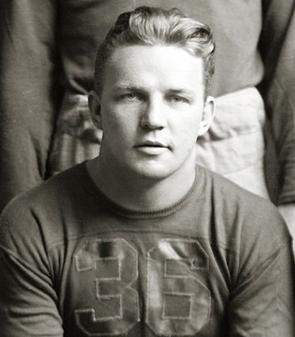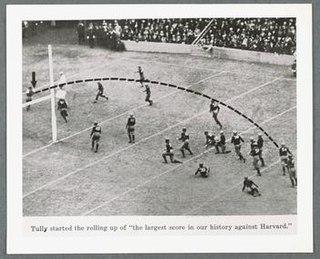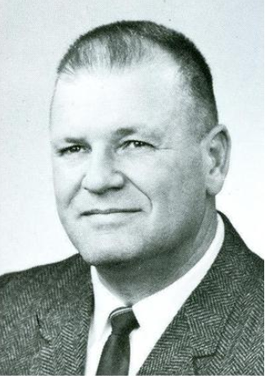
Ralph Isaac "Hike" Heikkinen was an All-American guard for the University of Michigan Wolverines football team from 1936 to 1938. He was a unanimous All-American in 1938, the first player from the Gogebic Range area of Michigan's Upper Peninsula to win the honor. His exploits were widely reported in the Upper Peninsula press, where he became a local hero. He played professional football in the National Football League (NFL) with the Brooklyn Dodgers in 1939.

The 1925 college football season ended with no clear national champion. At the close of the season, noted sports writer Billy Evans described the championship contest as "a dead heat" among Dartmouth, Tulane, Michigan, Washington, and Alabama.
The 2001 North Dakota Fighting Sioux football team represented University of North Dakota in the 2001 NCAA Division II football season. The Fighting Sioux won the NCAA Division II national championship, the team's first. Their head coach was Dale Lennon, a former fullback for the school. The team's quarterback was junior Kelby Klosterman, who threw thirty-two touchdowns and seven interceptions. The leading rusher was Jed Perkerewicz, who rushed for almost eight-hundred yards and seven touchdowns. Three receivers had at least eight touchdowns; Dan Graf had ten, Jesse Smith had nine, and Luke Schleusner had eight. Mac Schneider, an American attorney who now serves as United States Attorney for the District of North Dakota, started three games in a backup role as offensive lineman for the team and served as team captain his senior year. The defense had a plus nineteen turnover margin and allowed fewer than thirteen points a game and just three rushing touchdowns all season. Eric Schmidt led the defense with ten sacks.
Joseph Raymond O'Donnell was an American football player. He played college football as a fullback, guard and tackle for the University of Michigan from 1960 to 1963. He also played professional football as a guard and tackle for eight seasons for the Buffalo Bills in the American Football League (AFL) and the National Football League (NFL). He was a part of the 1964 and 1965 AFL Championship teams. O'Donnell was an AFL Eastern Division All-Star in 1965. He also came out of retirement to play in the World Football League (WFL) in 1974 and 1975.

Omer LaJeunesse was an American football player and coach. He played football at the University of Michigan from 1929 to 1931. LaJeunesse served as the head football coach of at Michigan College of Mining and Technology—now known as Michigan Technological University from 1957 to 1962 and the head coach of the swim team from 1954 through at least 1969.
The 1948 Northern Illinois State Huskies football team represented Northern Illinois State Teachers College—now known as Northern Illinois University—as a member of the Illinois Intercollegiate Athletic Conference (IIAC) during the 1948 college football season. Led by 20th-year head coach Chick Evans, the Huskies compiled an overall record of 6–4 with a mark of 2–2 in conference play, placing third in the IIAC.
The 1955 Northern Illinois State Huskies football team represented Northern Illinois State College—now known as Northern Illinois University—as a member of the Interstate Intercollegiate Athletic Conference (IIAC) during the 1955 college football season. Led by Bob Kahler in his first and only season as head coach, the Huskies compiled an overall record of 0–8–1 with a mark of 0–5–1 in conference play, placing last out of seven teams in the IIAC. The team played home games at the 5,500-seat Glidden Field, located on the east end of campus, in DeKalb, Illinois.
The 1968 small college football rankings are rankings of college football teams representing smaller college and university teams during the 1968 college football season, including the 1968 NCAA College Division football season and the 1968 NAIA football season. Separate rankings were published by the Associated Press (AP) and the United Press International (UPI). The AP rankings were selected by a board of sports writers, and the UPI rankings were selected by a board of small-college coaches.
The 1961 small college football rankings are rankings of college football teams representing smaller college and university teams during the 1961 college football season, including the 1961 NCAA College Division football season and the 1961 NAIA football season. Separate rankings were published by the Associated Press (AP) and the United Press International (UPI). The AP rankings were selected by a board of experts, and the UPI rankings were selected by a board of small-college coaches from throughout the country.
The 1930 Michigan Tech Huskies football team represented Michigan Technological University as an independent in the 1930 college football season. Led by second-year head coach Bert Noblet, the Huskies compiled a record of 1–5.
The 2008 Minnesota–Duluth Bulldogs football team was an American football team that won the 2008 NCAA Division II national championship.
The 2010 Minnesota–Duluth Bulldogs football team was an American football team that won the 2010 NCAA Division II national championship. The team was the first in NCAA Division II history to twice compile a perfect 15–0 record.

The 1967 Fairmont State Falcons football team was an American football team that represented Fairmont State University as a member of the West Virginia Intercollegiate Athletic Conference (WVIAC) during the 1967 NAIA football season. In their 16th season under head coach Harold "Deacon" Duvall, the Falcons compiled a perfect 11–0 record and won the WVIAC championship. The team advanced to the NAIA playoffs where they defeated Northern Michigan in the semifinals and then beat Eastern Washington in the Champion Bowl to win the 1967 NAIA national championship. The team led the NAIA in defense, allowing only 119.8 yards per game.
The 1946 Michigan Tech Huskies football team was an American football team that represented Michigan College of Mining and Technology as an independent during the 1946 college football season. In their first and only year under head coach Rex Benoit, the Huskies compiled a 3–2 record and were outscored by a total of 54 to 49.
The 1946 Minnesota Teachers College Conference football season was the season of college football played by the six member schools of the Minnesota Teachers College Conference as part of the 1946 college football season. Mankato State and Duluth State were co-champions of the conference. None of the Minnesota Teachers College Conference teams was ranked in the Associated Press poll or played in a bowl game.

Madeo "Moon" Molinari was an American athlete and sports coach. He was best known for his time at Winona State University, where he coached football, baseball, and golf for many years.
The 1974 Michigan Tech Huskies football team was an American football team that represented Michigan Technological University as a member of the Northern Intercollegiate Conference (NIC) during the 1974 National Association of Intercollegiate Athletics NAIA season. In their second year under head coach Jim Kapp, the Huskies compiled a perfect 9–0 record, won the NIC championship, and outscored opponents by a total of 269 to 90. It was Michigan Tech's first perfect season since the 1948 team went 7–0. It was also the program's first nine-win season, and its fourth NIC championship in six years.
The 1948 Michigan Tech Huskies football team was an American football team that represented the Michigan College of Mining and Technology as an independent during the 1948 college football season. In their second year under head coach Alan Bovard, the Huskies compiled a perfect 7–0 record and outscored opponents by a total of 209 to 58.
The 1980 Minnesota–Duluth Bulldogs football team was an American football team that represented the University of Minnesota Duluth (UMD) as a member of the Northern Intercollegiate Conference during the 1980 NCAA Division II football season. In its 23rd year under head coach Jim Malosky, UMD compiled a 10–0 record and won the NIC championship. It was the first perfect season in the history of the UMD football program and its first outright conference championship since 1938.
The 1961 Northern Michigan Wildcats football team was an American football team that represented Northern Michigan College as an independent during the 1961 college football season. In their fifth season under head coach Frosty Ferzacca, the Wildcats compiled a 6–2 record and outscored opponents by a total of 252 to 69, and were ranked No. 7 in the final UPI small college poll. They had been ranked No. 1 in the UPI polls released on October 18 and October 25 and No. 2 in the poll released on November 8.





